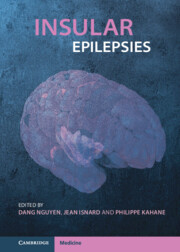Book contents
- Insular Epilepsies
- Insular Epilepsies
- Copyright page
- Contents
- Contributors
- Foreword
- Chapter 1 A Brief History of Insular Cortex Epilepsy
- Section 1 The Human Insula from an Epileptological Standpoint
- Section 2 The Spectrum of Epilepsies Involving the Insula
- Section 3 Noninvasive Investigation of Insular Epilepsy
- Section 4 Invasive Investigation of Insular Epilepsy
- Section 5 Surgical Management of Insular Epilepsy
- Chapter 22 Insular Epilepsy Surgery: Surgical Techniques and Experience of Various Centers
- Chapter 23 Stereoelectroencephalography (SEEG)–Guided Radiofrequency Thermocoagulation (RFTC) of Insular Epileptic Foci
- Chapter 24 Neurostimulation for the Treatment of Insular Epilepsy
- Chapter 25 Laser Interstitial Thermal Therapy (LITT) for Insular Epilepsy
- Epilogue
- Index
- References
Chapter 24 - Neurostimulation for the Treatment of Insular Epilepsy
from Section 5 - Surgical Management of Insular Epilepsy
Published online by Cambridge University Press: 09 June 2022
- Insular Epilepsies
- Insular Epilepsies
- Copyright page
- Contents
- Contributors
- Foreword
- Chapter 1 A Brief History of Insular Cortex Epilepsy
- Section 1 The Human Insula from an Epileptological Standpoint
- Section 2 The Spectrum of Epilepsies Involving the Insula
- Section 3 Noninvasive Investigation of Insular Epilepsy
- Section 4 Invasive Investigation of Insular Epilepsy
- Section 5 Surgical Management of Insular Epilepsy
- Chapter 22 Insular Epilepsy Surgery: Surgical Techniques and Experience of Various Centers
- Chapter 23 Stereoelectroencephalography (SEEG)–Guided Radiofrequency Thermocoagulation (RFTC) of Insular Epileptic Foci
- Chapter 24 Neurostimulation for the Treatment of Insular Epilepsy
- Chapter 25 Laser Interstitial Thermal Therapy (LITT) for Insular Epilepsy
- Epilogue
- Index
- References
Summary
The surgical treatment of refractory insular epilepsy is challenging because of its deep-seated anatomical location, the rich vasculature within this region, and its connectivity with highly eloquent brain regions. Neurostimulation is a burgeoning complementary treatment for drug-resistant epilepsy patients who may not be candidates for surgical resection. There is Class I evidence supporting the efficacy and safety of responsive neurostimulation (RNS), vagus nerve stimulation (VNS), and deep brain stimulation (DBS) of the anterior nucleus of the thalamus. All of these modalities have comparable efficacy, as demonstrated in their respective pivotal trials and subsequent longer-term trials. There is, however, a paucity of published data at this time describing their use specifically for the treatment of refractory extratemporal epilepsy or insular epilepsy in particular.
Keywords
- Type
- Chapter
- Information
- Insular Epilepsies , pp. 278 - 286Publisher: Cambridge University PressPrint publication year: 2022



